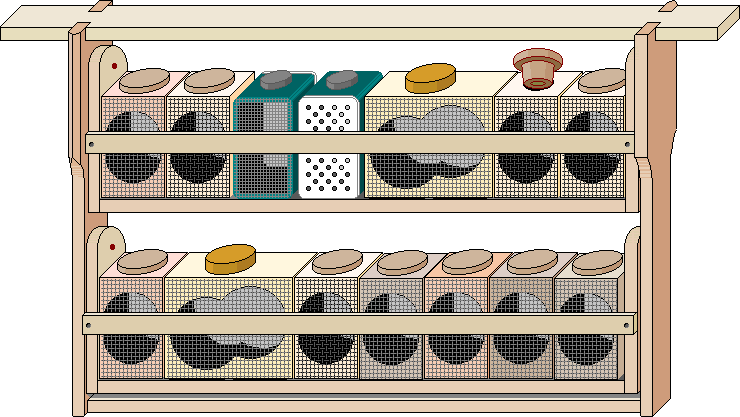Special & Unusual Frames
Nursery Cages
|
|
|
|---|
|
Special & Unusual Frames Nursery Cages |
Nursery Frame For Storage and Feeding Of Queen Honey Bees |
|---|
A wooden frame that fits into a B.S. bee hive, which can hold several mesh covered wooden queen cages that in turn each hold an unmated queen honey bee.
There are many types of nursery cage, but the majority of them can be 'mixed and matched', I have shown this in the drawing which has examples of Thorne's type, my double width version and two views of a plastic cage that is thought to come from Poland. The cages are held in two sub frames that can be independently swivelled for easy insertion of the cages.
One of cages has it's stopper left out showing the form the plug takes, the base of the stopper has a blind bored hole of approximately 11 mm in diameter that can have a queen cup formed by placing a pellet of warmed beeswax in the hole and forcing a forming stick into the soft wax, which extrudes the wax into a cup shape, twist the stick in order that it does not adhere to the wax and withdraw, once such a cup is grafted and built up to sealing stage elsewhere it can be inserted in the cage for emergence.
Some of the wooden plugs have been such a loose fit in their hole that I have shrunk on short lengths of 'heat-shrink sleeving' to the smaller diameter portion, as a radio amateur, that sort of stuff is always lurking in my toolbox... Radio shack, Tandy or Maplins would make a suitable port of call if you require some.
The cell plug holders from the various cell plug box kits can be used in a similar manner, many of these are not a tight fit in the holes at the cage top, but they are usually heavy enough for this not to be a problem. Always remember that you want to try and keep a queencell oriented in a vertical fashion and that will stop any accidental falling out of a plug and cell.

The cages are described on the introduction page and queen cages pages. The mesh on the cage face needs to be about 8 mesh in order that the apertures are adequately sized to allow for the queens to be properly fed, the plastic cage has a mesh that has apertures just under 2 mm square, but the wire of the mesh is so thin that the smallness of mesh does not restrict the workers' ability to feed the queen.
The distinction needs to be made between a queen nursery and the process of queen banking. A nursery situation usually refers to virgin queens that have actually emerged from their cells into the cages. In a queen banking situation we are usually storing queens that have been mated and are temporarily surplus to immediate requirements. The processes are similar and the conditions within the hive that is looking after the queens can be the same, although it is common to bank mated queens in honey supers, nursery frames need to be supported in the manner outlined below. There is a significant difference in the amount of queen pheromone given off by a mated queen compared to a virgin.
The colony should be made up in a normal deep brood chamber, place a frame of honey on each outside wall and five or six frames of brood in the centre. One of these frames can, to advantage, be a damaged one that has had a portion of blank foundation spliced into the damaged area, this acts as a magnet for those workers that are intent on wax working and would otherwise attach wild comb to the nursery cages. This will provide enough worker bees to care for up to 3 nursery frames (or banking frames), young nurse bees are ensured by using the Marburg box to provide the workforce of bees. The source of the bees must also be closely related to the queens in the cages in the genetic sense and all virgin queens in the cages should also be closely related. The nursery box should be assessed every week and restocked with frames of brood, honey stores and young bees as required. Early stage brood is particularly useful as it stimulates the nurse bees to produce food. Supplemental feeding of pollen and honey (or syrup) may be required to ensure good care is taken of the virgin queens.
At all times this colony must remain queenless and checks should be made that queen cells are not raised in odd corners of the box that might be a long distance from the influence of the weak pheromones from the virgin queens in the cages.
Dave Cushman.
Page created 05/12/2006
Page updated 05/12/2022
Written... 05 December 2006,
|